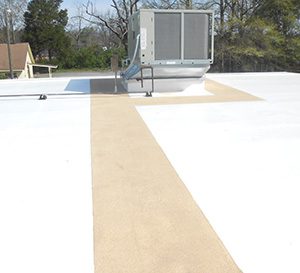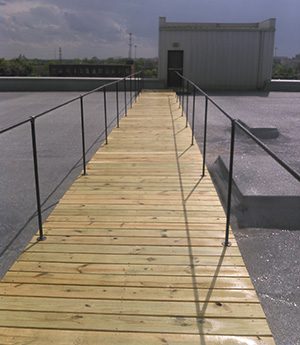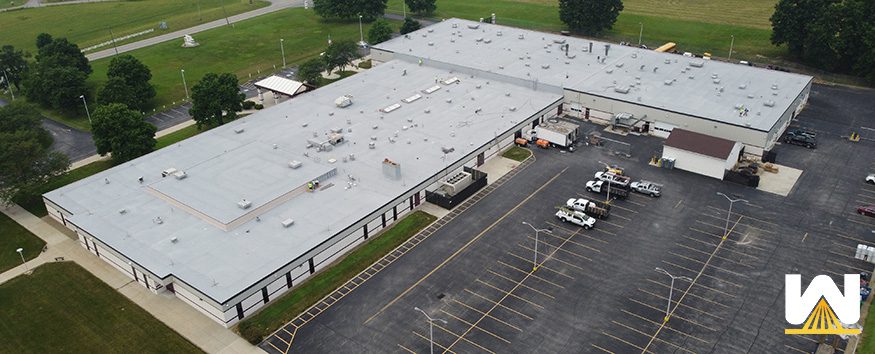Quick answer: A spray foam roof is the best roofing system to install with high foot traffic. The reason is that it’s 20x thicker than single-ply and has closed-cell properties.
So you have a roof with lots of foot traffic.
Perhaps, you’re a university where students go from one building to another along the roof?
Or, you run a facility where technicians are on your roof constantly?
Either way, you need a roof that can handle excessive foot traffic.
In this article, you’ll learn:
- The thickness levels of different roof systems
- Open-cell vs. closed-cell insulation and the effects they have on leaking
- 3 ways contractors handle roofs with high foot traffic
And just so you’re aware, West Roofing Systems has been in commercial roofing since 1979. Every project has unique challenges, including ones that need to account for excessive foot traffic.
This article has been edited, reviewed, and approved for publishing by one of our internal roofing specialists with more than 30 years of experience.
Let’s get started!
The thickness levels of different roof systems
What does thickness have to do with foot traffic?
It means a lot! The thicker the membrane, the less impact foot traffic will have on it.
A popular roofing system is single-ply, such as TPO or EPDM. These rubber sheets usually come in 45, 60, and 80 mil thicknesses.
A “mil” is one-thousandth of an inch. So, a 60-mil thickness is 0.060 inches thick.
Another popular roofing system is spray polyurethane foam.
Spray foam must be installed at least one inch thick for the system to perform at its max. The typical application is 2” at the perimeters, then tapered to 1” at the drains. The average thickness would be 1.5”.
Converting back to mils, 1.5 inches of a foam roof would have a thickness level of 1500 mils.
Open-cell vs. closed-cell insulation and the effects they have on leaking
Another factor to consider when seeking a roofing system to handle foot traffic is the type of insulation it has.
Is it open-cell or closed-cell?
Open-cell
Open-cell means that if water hits the material, water will saturate it and move up, down, and across the product until it’s soaked.
Think of open-cell insulation as being similar to a tissue. If you use an eye-dropper and add water to the tissue in a corner, eventually, the entire tissue is soaked.
Eventually, the materials will become so saturated that water drips further down into the next area of your roof, which is usually your deck.
Closed-cell
Closed-cell doesn’t allow water to travel through them. If the insulation gets a crack, hole, or puncture, water sits in that hole and doesn’t move.

Since roofs are exposed to hail, sharp branches, rocks, and other debris that could be stepped on with excessive foot traffic, the type of insulation you have can prevent expensive repairs or leakage into your building.
Other facts: Polyiso board is commonly used in commercial roofing and is open-celled. Spray polyurethane foam is closed-cell.
3 ways contractors handle roofs with high foot traffic
There are three ways roofing contractors can deal with high foot traffic:
- Use mats
- Install coating with granules
- Install a permanent walkway
Mats
An easy way to handle foot traffic and highlight walking areas is to lay down mats. These are inexpensive but can be moved, blown away, etc.
Coating and granules
Single-ply roofs can highlight walkways by installing an elastomeric coating. They can also embed granules into that coating for extra strength.

Spray foam roofs are all installed with an elastomeric coating over the top. The contractor can also embed granules into the coating to add the strength needed to handle lots of foot traffic.
Permanent walkways
The last way to handle foot traffic is to install a walkway that hovers the roof.

While this may be costly compared to the other options, it’s a way to add aesthetics and stability to a roof.
Conclusion
Hopefully, you learned about the thickness of popular roofing systems, open vs. closed-cell insulation, different walkway options, and how they handle excessive foot traffic.
Want to learn more?
Here are some popular articles:


